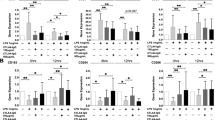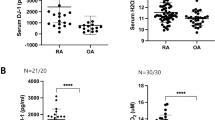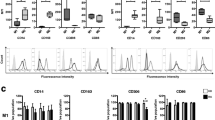Abstract
1,25-Dihydroxyvitamin D (1,25(OH)2D3), the active form of vitamin D, modulates both innate and adaptive immune responses. Emerging epidemiological data has also demonstrated disease-modifying and immunomodulatory effects of vitamin D in a wide range of human autoimmune diseases, including rheumatoid arthritis (RA). To evaluate in vitro effects of 1,25(OH) 2D3 in primary cultures of peripheral blood monocyte-derived macrophages of RA patients, monocyte/macrophages, isolated from peripheral blood mononuclear cells of RA patients and healthy subjects by exploiting their ability to adhere to plastic, were treated with increasing concentrations of 1,25(OH)2D3 for 48 h. TNF-α, IL-1 α, IL-1β, IL-6 and RANKL production was determined by ELISA and nitric oxide (NO) release using the Griess method. Immunocytochemistry analysis was also performed to evaluate alterations in transmembrane TNF-α expression after 1,25(OH) 2D3 treatment. A significant dose-dependent decrease in TNF-α and RANKL production by cultured RA macrophages after 1,25(OH)2D3 treatment was found, whereas a significant reduction in normal cells was observed only at higher concentrations. IL-1 α, IL-1β and IL-6 levels were reduced by 1,25(OH) 2D3 at higher concentrations in all cell populations. TNF-α immunostaining was less intense in treated cells compared with untreated. 1,25(OH) 2D3 significantly reduced NO levels regardless of the concentration used. Vitamin D downregulated proinflammatory mediators in monocyte-derived macrophages, and RA cells appeared more sensitive than normal cells. These effects further provide a rationale for the therapeutic value of vitamin D supplementation in the treatment for RA.






Similar content being viewed by others
References
Maruotti N, Cantatore FP. (2010) Vitamin D and the immune system. J Rheumatol 37(3):491–495 [Epub 2010 Jan 15]
Choy EH (2006) Joint inflammation and cytokine inhibition in rheumatoid arthritis. Clin Exp Med 6:13–19
Maruotti N, Cantatore FP, Crivellato E et al (2007) Macrophages in rheumatoid arthritis. Histol Histopathol 22:581–586
Mulherin D, Fitzgerald O, Bresnihan B (1996) Synovial tissue macrophage populations and articular damage in rheumatoid arthritis. Arthritis Rheum 39:115–124
Hummel KM, Petrow PK, Franz JK et al (1998) Cysteine proteinase cathepsin K mRNA is expressed in synovium of patients with rheumatoid arthritis and is detected at sites of synovial bone destruction. J Rheumatol 25:1887–1894
Hou WS, Li W, Keyszer G et al (2002) Comparison of cathepsins K and S expression within the rheumatoid and osteoarthritic synovium. Arthritis Rheum 46:663–674
Schulze-Koops H, Davis LS, Kavanaugh AF et al (1997) Elevated cytokine messenger RNA levels in the peripheral blood of patients with rheumatoid arthritis suggest different degrees of myeloid cell activation. Arthritis Rheum 40:639–647
Lioté F, Boval-Boizard B, Weill D et al (1996) Blood monocyte activation in rheumatoid arthritis: increased monocyte adhesiveness, integrin expression, and cytokine release. Clin Exp Immunol 106:13–19
Lavagno L, Gunella G, Bardelli C et al (2004) Anti-inflammatory drugs and tumor necrosis factor-alpha production from monocytes: role of transcription factor NF-kappa B and implication for rheumatoid arthritis therapy. Eur J Pharmacol 501:199–208
Aletaha D, Neogi T, Silman AJ et al (2010) Rheumatoid arthritis classification criteria: an American College of Rheumatology/European League Against Rheumatism collaborative initiative. Arthritis Rheum 62:2569–2581
Rausch-Fan X, Leutmezer F, Willheim M et al (2002) Regulation of cytokine production in human peripheral blood mononuclear cells and allergen-specific th cell clones by 1alpha,25-dihydroxyvitamin D3. Int Arch Allergy Immunol 128:33–41
Schmittgen TD, Livak KJ (2008) Analyzing real-time PCR data by the comparative C(T) method. Nat Protoc 3:1101–1108
Cantorna MT, Hayes CE, DeLuca HF (1996) 1,25-Dihydroxyvitamin D3 reversibly blocks the progression of relapsing encephalomyelitis, a model of multiple sclerosis. Proc Natl Acad Sci USA 93:7861–7864
Cutolo M, Otsa K, Laas K et al (2006) Circannual Vitamin D serum levels and disease activity in rheumatoid arthritis: northern versus Southern Europe. Clin Exp Rheumatol 24:702–704
Andjelkovic Z, Vojinovic J, Pejnovic N et al (1999) Disease modifying and immunomodulatory effects of high dose 1 alpha (OH) D3 in rheumatoid arthritis patients. Clin Exp Rheumatol 17:453–456
Cantorna MT, Hayes CE, DeLuca HF (1998) 1,25-Dihydroxycholecalciferol inhibits the progression of arthritis in murine models of human arthritis. J Nutr 128:68–72
Caporali R, Sarzi-Puttini P, Atzeni F et al (2010) Switching TNF-alpha antagonists in rheumatoid arthritis: the experience of the LORHEN registry. Autoimmun Rev 9:465–469
Atzeni F, Sarzi-Puttini P, Gorla R, Marchesoni A, Caporali R (2011) Switching rheumatoid arthritis treatments: an update. Autoimmun Rev 10:397–403
Alsalameh S, Winter K, Al-Ward R, Wendler J, Kalden JR, Kinne RW (1999) Distribution of TNF-alpha, TNF-R55 and TNF-R75 in the rheumatoid synovial membrane: TNF receptors are localized preferentially in the lining layer; TNF-alpha is distributed mainly in the vicinity of TNF receptors in the deeper layers. Scand J Immunol 49:278–285
Georgopoulos S, Plows D, Kollias G (1996) Transmembrane TNF is sufficient to induce localized tissue toxicity and chronic inflammatory arthritis in transgenic mice. J Inflamm 46:86–97
Alexopoulou L, Pasparakis M, Kollias G (1997) A murine transmembrane tumor necrosis factor (TNF) transgene induces arthritis by cooperative p55/p75 TNF receptor signaling. Eur J Immunol 27:2588–2592
Kinne RW, Bräuer R, Stuhlmüller B et al (2000) Macrophages in rheumatoid arthritis. Arthritis Res 2:189–202
McInnes IB, Schett G (2007) Cytokines in the pathogenesis of rheumatoid arthritis. Nat Rev Immunol 7:429–442
Obermeier F, Gross V, Schölmerich J (1999) Interleukin-1 production by mouse macrophages is regulated in a feedback fashion by nitric oxide. J Leukoc Biol 66:829–836
Baugh JA, Donnelly SC (2003) Macrophage migration inhibitory factor: a neuroendocrine modulator of chronic inflammation. J Endocrinol 179:15–23
Zhang Y, Leung DY, Richers BN et al (2012) Vitamin D inhibits monocyte/macrophage proinflammatory cytokine production by targeting MAPK phosphatase-1. J Immunol 188:2127–2135
Rego D, Kumar A, Nilchi L, Wright K, Huang S, Kozlowski M (2011) IL-6 production is positively regulated by two distinct Src homology domain 2-containing tyrosine phosphatase-1 (SHP-1)-dependent CCAAT/enhancer-binding protein β and NF-κB pathways and an SHP-1-independent NF-κB pathway in lipopolysaccharide-stimulated bone marrow-derived macrophages. J Immunol 186:5443–5456
Geng Y, Zhang B, Lotz M (1993) Protein tyrosine kinase activation is required for lipopolysaccharide induction of cytokines in human blood monocytes. J Immunol 151:6692–6700
Nagy G, Koncz A, Fernandez D et al (2007) Nitric oxide, mitochondrial hyperpolarization, and T cell activation. Free Radic Biol Med 42:1625–1631
Chae HJ, Park RK, Chung HT et al (1997) Nitric oxide is a regulator of bone remodelling. J Pharm Pharmacol 49:897–902
Miesel R, Murphy MP, Kröger H (1996) Enhanced mitochondrial radical production in patients with rheumatoid arthritis correlates with elevated levels of tumor necrosis factor alpha in plasma. Free Radic Res 25:161–169
Neve A, Corrado A, Cantatore FP (2011) Osteoblast physiology in normal and pathological conditions. Cell Tissue Res 343:289–302
Pettit AR, Walsh NC, Manning C et al (2006) RANKL protein is expressed at the pannus-bone interface at sites of articular bone erosion in rheumatoid arthritis. Rheumatology (Oxford) 45:1068–1076
Gravallese EM, Harada Y, Wang JT et al (1998) Identification of cell types responsible for bone resorption in rheumatoid arthritis and juvenile rheumatoid arthritis. Am J Pathol 152:943–951
Pettit AR, Ji H, von Stechow D et al (2001) TRANCE/RANKL knockout mice are protected from bone erosion in a serum transfer model of arthritis. Am J Pathol 159:1689–1699
Kong YY, Feige U, Sarosi I et al (1999) Activated T cells regulate bone loss and joint destruction in adjuvant arthritis through osteoprotegerin ligand. Nature 402:304–309
Redlich K, Hayer S, Maier A et al (2002) Tumor necrosis factor alpha-mediated joint destruction is inhibited by targeting osteoclasts with osteoprotegerin. Arthritis Rheum 46:785–792
Lubberts E, van den Bersselaar L, Oppers-Walgreen B et al (2003) IL-17 promotes bone erosion in murine collagen-induced arthritis through loss of the receptor activator of NF-kappa B ligand/osteoprotegerin balance. J Immunol 170:2655–2662
Corrado A, Neve A, Macchiarola A, Gaudio A, Marucci A, Cantatore FP (2013) RANKL/OPG ratio and DKK-1 expression in primary osteoblastic cultures from osteoarthritic and osteoporotic subjects. J Rheumatol 40:684–694
Thomas GP, Baker SU, Eisman JA, Gardiner EM (2001) Changing RANKL/OPG mRNA expression in differentiating murine primary osteoblasts. J Endocrinol 170:451–460
Takasu H (2008) Anti-osteoclastogenic action of active vitamin D. Nutr Rev 66(10 Suppl 2):S113–S115
Maruotti N, Grano M, Colucci S et al (2011) Osteoclastogenesis and arthritis. Clin Exp Med 11:137–145
Fuller K, Murphy C, Firstein B, Fox SW, Chambers TJ (2002) TNFalpha potently activates osteoclasts, though a direct action independent and strongly synergistic with RANKL. Endocrinology 143:1108–1118
Luo J, Wen H, Guo H, Cai Q, Li S, Li X (2013) 1,25-Dihydroxyvitamin D3 inhibits the RANKL pathway and impacts on the production of pathway-associated cytokines in early rheumatoid arthritis. Biomed Res Int 2013:101805. doi:10.1155/2013/101805 [Epub 2013 Apr 22]
Conflict of interest
None.
Author information
Authors and Affiliations
Corresponding author
Rights and permissions
About this article
Cite this article
Neve, A., Corrado, A. & Cantatore, F.P. Immunomodulatory effects of vitamin D in peripheral blood monocyte-derived macrophages from patients with rheumatoid arthritis. Clin Exp Med 14, 275–283 (2014). https://doi.org/10.1007/s10238-013-0249-2
Received:
Accepted:
Published:
Issue Date:
DOI: https://doi.org/10.1007/s10238-013-0249-2




